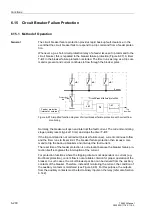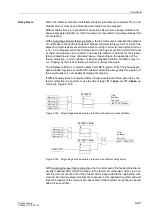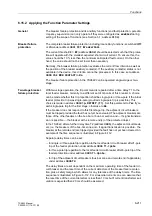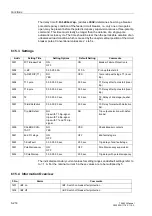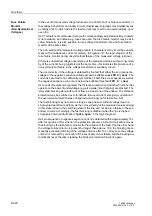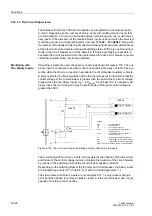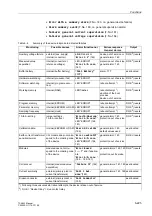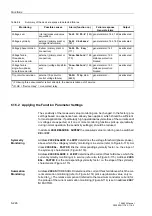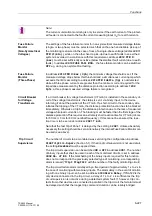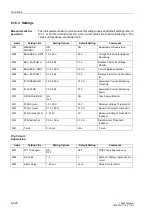
Functions
6-213
7SA522 Manual
C53000-G1176-C119-2
Figure 6-113 Time sequence example for normal clearance of a fault, and with circuit breaker
failure, using single-stage breaker failure protection
Circuit breaker not
operational
If the circuit breaker associated with the feeder is not operational (e.g. control voltage
failure or air pressure failure), it is apparent that the local breaker cannot clear the
fault. Time delay before tripping the adjacent breakers is not necessary in this case. If
the relay is informed about this disturbance (via the binary input “
”, the
adjacent circuit breakers (bus-bar and remote end if applicable) are tripped after the
time
(address
) which is usually set to
.
Address
determines to which output the trip command is routed in the event that
the breaker is not operational when a feeder protection trip occurs. Select that output
which is used to trip the adjacent breakers (bus-bar trip).
End fault protection
The end fault protection can be switched
2Q
or
2II
separately under address
. An end fault is a short-circuit between the circuit breaker and the
current transformer set of the feeder. The end fault protection presumes that the de-
vice is informed about the circuit breaker position via breaker auxiliary contacts con-
nected to binary inputs.
If, during an end fault, the circuit breaker is tripped by a reverse fault stage of the feed-
er protection or by the bus-bar protection (the fault is a bus-bar fault as determined
from the location of the current transformers), the fault current will continue to flow, be-
cause the fault is fed from the remote end of the feeder circuit.
The time
(address
) is started when, during the fault detection con-
dition of the feeder protection, the circuit breaker auxiliary contacts indicate open
poles and, at the same time, current flow is detected (address
). The trip com-
mand of the end fault protection is intended for the transmission of an intertrip signal
to the remote end circuit breaker.
Thus, the delay time must be set such that it can bridge out short transient apparent
end fault conditions which may occur during switching of the breaker.
Pole discrepancy
supervision
The pole discrepancy supervision can be switched
2Q
or
2II
separately under ad-
dress
. It is only useful if the breaker poles can be operated
individually. It avoids that only one or two poles of the local breaker are open continu-
ously. It has to be provided with either the breaker auxiliary contacts of each pole or
the series connection of the normally open contacts (NO contacts) and the normally
closed contacts (NC contacts) to binary inputs on the device. If these conditions are
not fulfilled, switch the pole discrepancy supervision
2II
.
Fault inception
Fault clearance time normal
Prot.
trip
CB operating time
Reset
I–BF
Safety
margin
CB–operating time
(adjacent CBs)
Initiation breaker
failure protection
Time delay T2 of breaker
failure protection
Total fault clearance time with breaker failure
Summary of Contents for siprotec 7SA522
Page 20: ...7SA522 Manual C53000 G1176 C119 2 ...
Page 64: ...7SA522 Manual C53000 G1176 C119 2 ...
Page 89: ...SIPROTEC 4 Devices 4 25 7SA522 Manual C53000 G1176 C119 2 Figure 4 20 CFC Logic example ...
Page 408: ...7SA522 Manual C53000 G1176 C119 2 ...
Page 456: ...7SA522 Manual C53000 G1176 C119 2 ...
Page 516: ...7SA522 Manual C53000 G1176 C119 2 ...
Page 620: ...Appendix B 48 ...


